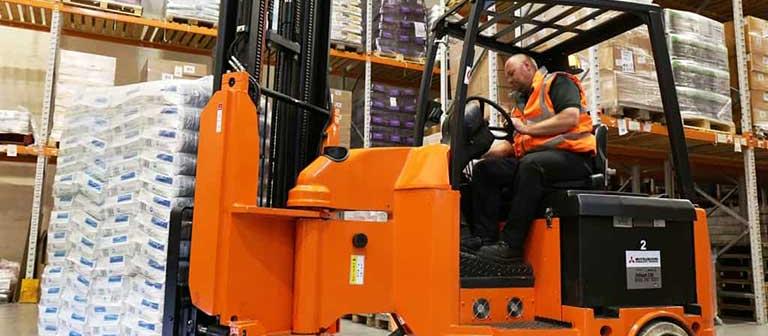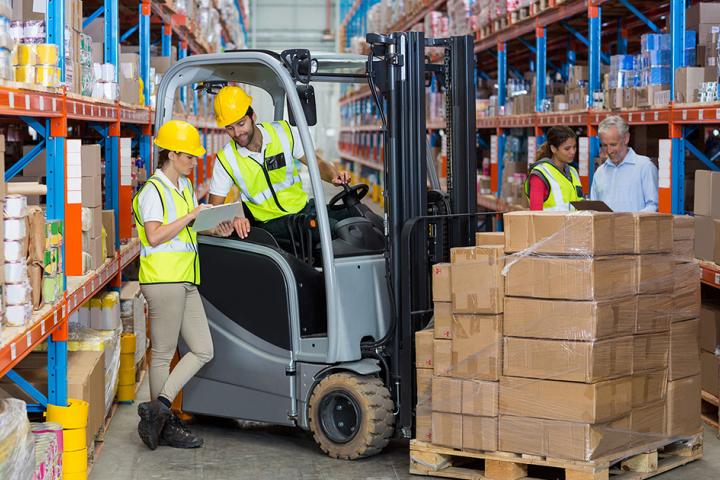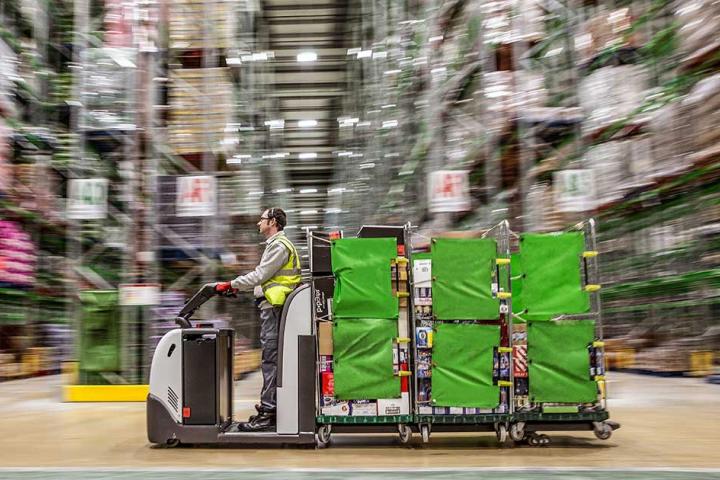How articulated forklift trucks are rewriting the rules.
In this article, the focus will be articulated forklift trucks. We’ll take a close look at the different models and their specification. We’ll also look at the reason why they are so useful providing benefits unique to this forklift truck type. First, let's have a little history lesson about where they came from.
The very first articulated forklift truck is said to have been perfected in 1982 by a man called Frederick L Brown. Brown took his inspiration from a manual pallet truck that utilises a triangular weight distribution concept.
If you draw a line from wheel to wheel on a pallet truck it forms a triangle shape. This triangle configuration provides both stability and excellent manoeuvrability. Having one wheel in the triangle operate as a swivel enables the pallet truck to turn on a very tight circle.
Brown, having worked in the materials handling industry for many years understood the importance of proper use of warehouse storage space and the need for maximising capacity wherever possible.
The articulated forklift truck has a central pivot point allowing the forks to move independently of the driver's cab. The central pivot of the truck allows pallets to be stored in racks at a right angle to the truck. Because the larger portion of the truck can remain straight while loading the pallet racking at a right angle means the truck aisle can be narrower. Having narrower aisle widths increases storage capacity.
Earlier attempts at an articulated forklift truck were unstable and slow. By reversing the unique triangle of stability and the weight distribution he solved these issues. In 2002 Brown received an award from the Forklift Truck Association and the Queen's Award for innovation in 2003.

What problems do articulated forklift trucks solve?
Articulated forklift trucks offer many benefits over many other truck types. Handling goods can require the use of several different pieces of lifting equipment. These could include a counterbalance forklift to initially unload the goods from a parked vehicle. Once the goods have been transferred to the warehouse a separate vehicle or manual pallet truck could be used to place the goods into a marshalling area.
The counterbalance truck may be reserved for offloading vehicles as it is best suited for the job. If the goods are to be stored in a VNA pallet racking system they would need to be handled again for placement into a P&D station which is often associated with VNA. A VNA truck would then collect the pallet from the P&D station and place it into the racking.
One great benefit of an articulated forklift truck is its ability to operate in a Very Narrow Aisle racking configuration. Aisles of as little as 1.6m are achievable which is usually the preserve of a VNA truck. Being able to operate in such a narrow aisle allows the pallet racking to be installed much tighter together and therefore creating more storage space.
An articulated forklift truck could never totally replace a VNA truck, the speed and efficiency that a VNA truck operates at could never be matched. VNA trucks are a completely different animal but that's not to say an articulated forklift doesn’t excel in other areas.
As businesses evolve so do their storage and handling requirements also change. When a company grows, in order to adapt to increasing storage requirements they usually have just two options. They can either extend their current warehouse facility or alternatively move premises. Investing in an articulated forklift truck gives them a third less disruptive option.
Reconfiguring the warehouse to suit an articulated forklift truck may just be enough to give them the increased capacity they need. This is the only type of truck that offers this unique benefit without going for an all-out VNA system.
One advantage over VNA is that articulated forklift trucks can work on a much wider variety of floor surface conditions. VNA requires a very flat even floor with minimal slope and this is exacerbated the higher the top beam level. Articulated forklift trucks are equipped with tyres suitable to operate on floors with a much lower specification allowing them to be used in most situations.

Be cautious of manufacturers recommendations.
Often manufacturers of articulated forklift trucks proudly state how narrow a pallet racking aisle can be in which their trucks can operate. In practice, this is not always the best advice to follow. Yes technically speaking an articulated forklift will most certainly work in the aisle width specified by the manufacturer.
Remember warehouse operations particularly in the case of 3PL companies often have service level agreements. These agreements are guarantees that the 3PL will maintain an agreed level of handling and storage. Moving an articulated forklift into position inch by inch because the aisle is so tight is not conducive to high productivity.
It is often recommended to add an additional 200mm to the manufacturer specified aisle width. By doing this the forklift driver can operate quicker with a reduced risk of damaging the pallet racking system. It also enables them to shave valuable seconds off each pallet movement. If storage capacity is of more importance than pick rate then by all means work to what the manufacturer recommends just be aware of the impact of work rate.
Articulated forklift trucks are an excellent alternative to a traditional counterbalance forklift truck. They are designed to operate just as well outside around the yard as they are inside of the warehouse. Being such a versatile, multipurpose truck means they offer other cost-saving benefits too. If you have a truck that can unload vehicles, shuttle pallets around the warehouse and locate goods into the pallet racking system regardless of aisle width means there's a potential for fewer trucks required on any site.
By using just one truck, warehouse managers can increase productivity in a number of ways. Double handling is the process of moving goods where the use of two or more types of lifting equipment is required. A counterbalance may be able to off-load a vehicle but it may not be suitable for loading pallets into the racking. This means at least two types of forklift are required on-site while other scenarios could require 3 or more.

Articulated forklift truck variations to consider.
Investing in an articulated forklift could improve truck-to-rack times. If the articulated forklift were to off-load, transfer and deposit straight into the pallet racking system only one truck is required. That's not to say it applies to all situations and there are many times when this just would not work. Depending on your individual situation it may be an option worth considering.
Available in electric or LPG powered models. The introduction of AC technology contributes to enhanced performance levels. Electric offers the benefit of fewer wearable parts which reduces downtime and lower maintenance costs. There are often various battery capacities available from most manufacturers meaning the optimal level of energy consumption can be achieved.
LPG models offer other benefits from alternative fuel-powered systems. LPG has reduced emission levels so are ideal for both indoor and outdoor use. LGP options also maintain higher uptime 24/7 operation can be maintained without loss of power. They utilize an engine bay cooling system for maximum reliability.
Most articulated forklift trucks are available in a number of variants. Lifting capacity is an important consideration when purchasing a truck of this type. Loading capacities from 1500kg up to 2500kg are available; this again qualifies them for most operational requirements.
Lift height is also of paramount importance when selecting a model. Pallet racking particularly VNA pallet racking can extend to heights in excess of 15m, some articulated forklift trucks can reach this height but anything above this is better serviced by a dedicated VNA truck.
Conclusion
With its flexibility, an articulated forklift truck can increase your storage capacity by up to 50% which is remarkable. Not limited to specific aisle width, articulated forklift trucks are just as at home working in larger aisles. The pivot point allows them to stack both left and right and can even be utilized for order picking situations. The system has even been used to create a walk behind reach truck stacker with electronic steering and fingertip controls for precise handling. They are a supremely versatile machine offering benefits in any type of environment.






